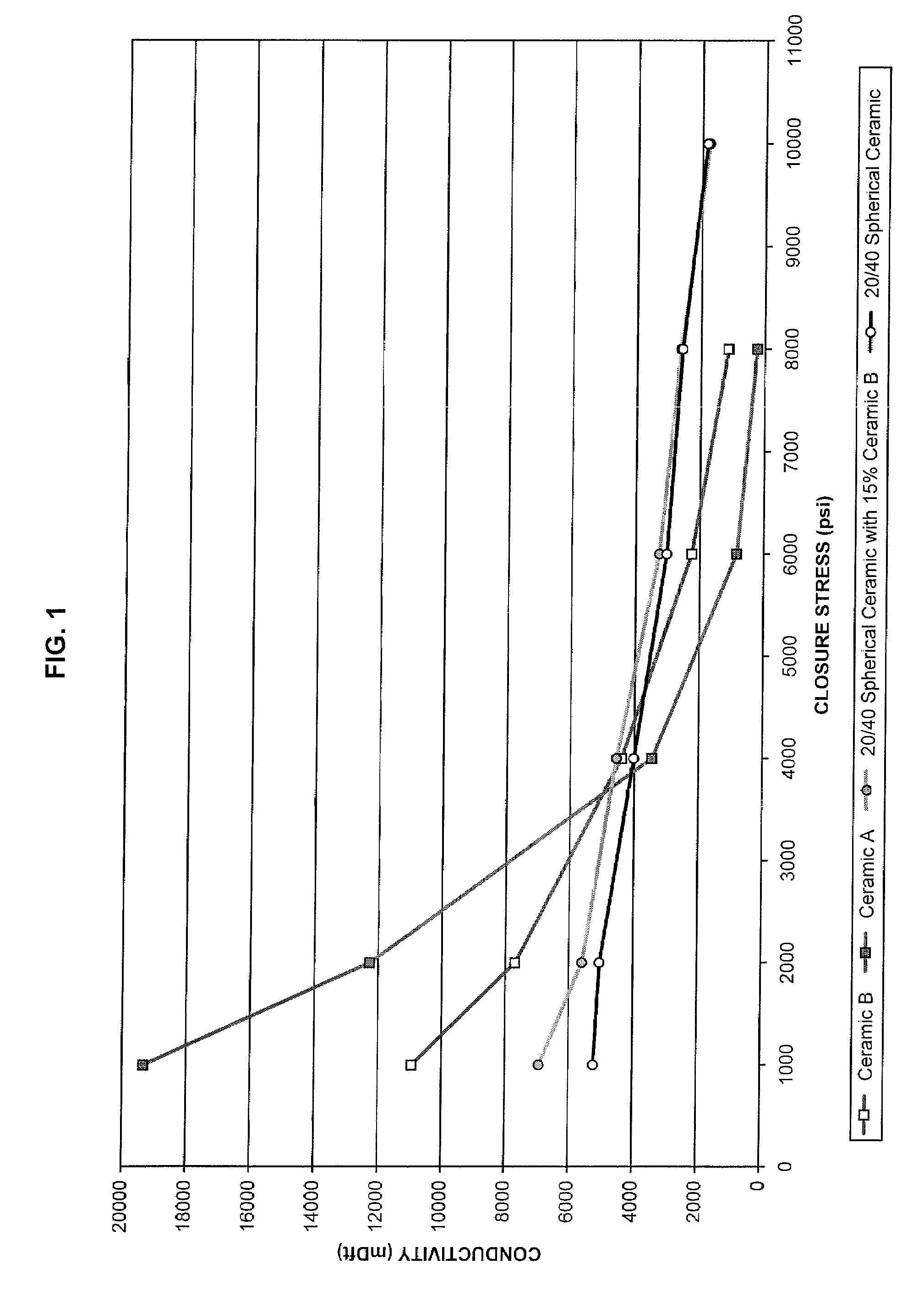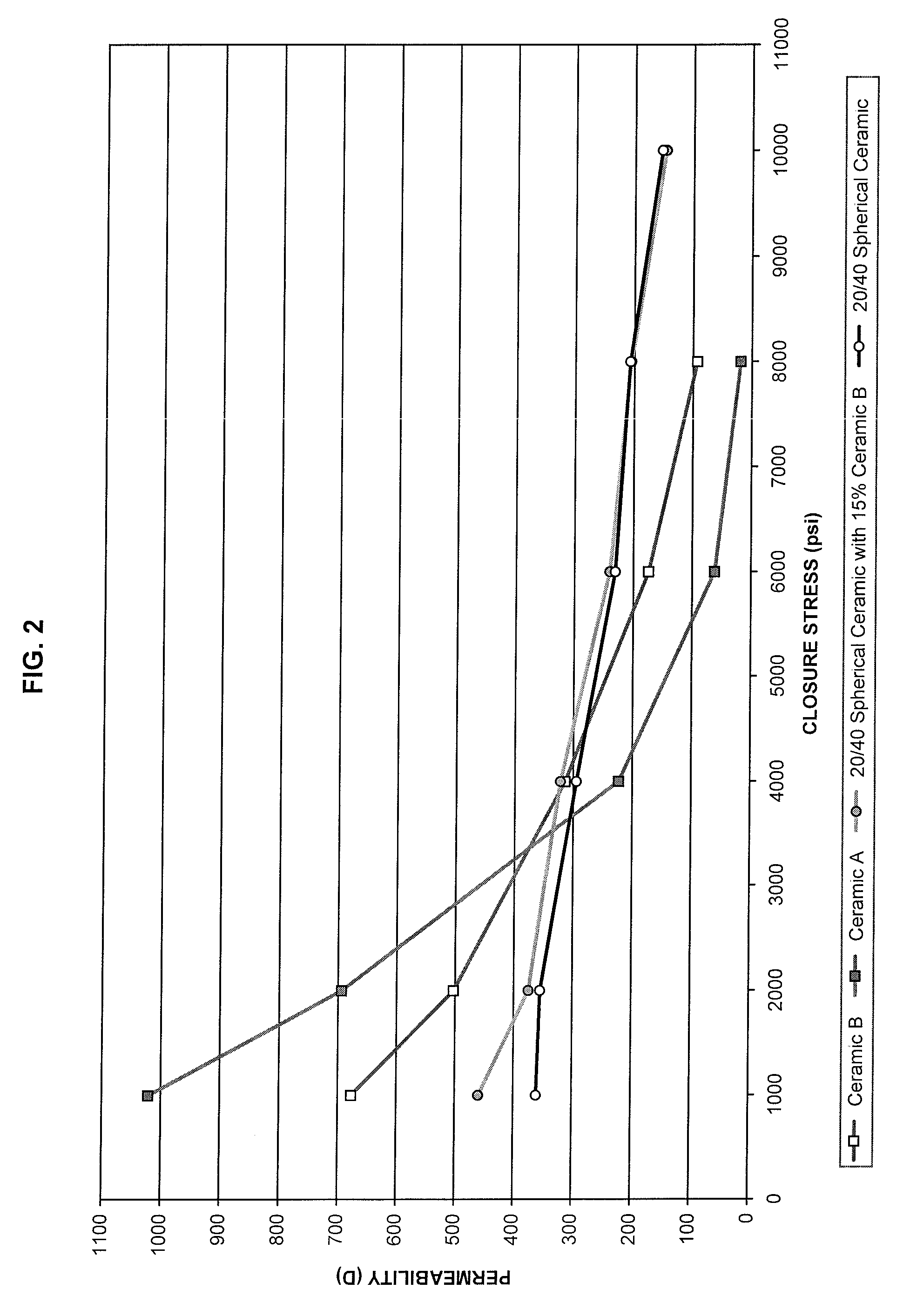Non-spherical well treating particulates and methods of using the same
a well and non-spherical technology, applied in the direction of well accessories, natural mineral layered products, cellulosic plastic layered products, etc., can solve the problems of increasing the difficulty of proppant transport, reducing the volume of propped fractures, and reducing fracture conductivity, so as to improve stress tolerance and strengthen the strength of composites
- Summary
- Abstract
- Description
- Claims
- Application Information
AI Technical Summary
Benefits of technology
Problems solved by technology
Method used
Image
Examples
example 1
[0057]This Example illustrates changes in porosity in a birch wood proppant pack when at least a portion of spherical proppant of 12 to 13 mm diameter was replaced with non-spherical proppant. The non-spherical birch wood was rod-shaped or cylindrical-shaped and had a diameter ranging from about 9 mm to about 10 mm and was about 50 mm long.
[0058]The measured specific gravity of the birch wood (spheres and rods) was 0.671 (+ / −0.039) (compared to a specific gravity of birch of 0.670, reported in the literature). The bulk density of the two wood shapes was determined by filling a measuring cylinder with the material to the 200 ml mark. The bulk density, mass / volume, and porosity were then determined.
Spherical Birch
Bulk density of spheres=0.331 g / cc (+ / −0.000)
Porosity=(1−0.331 / 0.670)×100=50.6%
Rod-Shaped Birch
Bulk Density of rods=0.229 g / cc (+ / −0.006)
Porosity=(1−0.229 / 0.670)×100=65.8%
A 50:50 and 75:25 by weight mixture of spherical birch:rod-shaped birch were then prepared and the bulk d...
example 2
[0060]This Example illustrates changes in porosity in a bauxite proppant pack when at least a portion of ceramic proppant is replaced with aluminum needles. The aluminum needles were cylindrical and had a diameter ranging from about 0.5 mm to about 0.75 mm and were about 2 mm to 4 mm long.
[0061]The measured specific gravity of the bauxite proppant was 2.728 (+ / −0.005). The measured specific gravity of the uncoated aluminum needles was 2.695 (+ / −0.013). Bulk density was determined in accordance with the procedure of Example 1 above.
20 / 40 Bauxite Ceramic
Bulk density=1.590 g / cc (+ / −0.000)
Porosity=(1−1.590 / 2.728)×100=41.7%
Uncoated Aluminum Needles
Bulk Density=1.030 g / cc (+ / −0.001)
Porosity=(1−1.030 / 2.695)×100=61.8%
A 50:50, 75:25 and 90:10 by weight mixture of bauxite ceramic:uncoated aluminum needles were then prepared and the bulk density of the mixtures were then determined as above.
50:50 Mixture
Bulk Density=1.341 g / cc (+ / −0.008)
Calculated specific gravity=2.711
Porosity=(1−1.341 / 2.711)...
example 3
[0063]Conductivity tests were performed according to a modified API RP 61 (1st Revision, Oct. 1, 1989) using an API conductivity cell with Ohio sandstone wafer inserts to simulate the producing formation. About 63 g of a multilayer pack of two types of ceramic rods (at 100%) were tested. Ceramic A consisted of cylindrical particulates ranging in diameter size from about 0.75 mm to about 1.0 mm and about 2 to about 4 mm long. Ceramic B consisted of cylindrical particulates ranging in size from about 0.5 to about 0.75 mm and a length of from about 2 to about 4 mm. Also tested was a 85:15 by weight blend of the ceramic rods with a 20 / 40 spherical ceramic proppant. A 100% pack of spherical ceramic proppant was also tested for comparison.
[0064]The conductivity cell was then placed on a press while stress was applied at 100 psi / minute until the target stress and temperature were reached. Fluid was then allowed to flow through the test pack maintaining Darcy flow. The differential pressure...
PUM
| Property | Measurement | Unit |
|---|---|---|
| porosity | aaaaa | aaaaa |
| temperature | aaaaa | aaaaa |
| sphericity | aaaaa | aaaaa |
Abstract
Description
Claims
Application Information
 Login to View More
Login to View More - R&D
- Intellectual Property
- Life Sciences
- Materials
- Tech Scout
- Unparalleled Data Quality
- Higher Quality Content
- 60% Fewer Hallucinations
Browse by: Latest US Patents, China's latest patents, Technical Efficacy Thesaurus, Application Domain, Technology Topic, Popular Technical Reports.
© 2025 PatSnap. All rights reserved.Legal|Privacy policy|Modern Slavery Act Transparency Statement|Sitemap|About US| Contact US: help@patsnap.com


